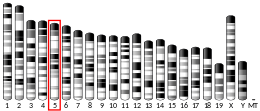PITPNB
Phosphatidylinositol transfer protein beta isoform is a protein that in humans is encoded by the PITPNB gene.[5][6]
The protein encoded by this gene is found in the cytoplasm, where it catalyzes the transfer of phosphatidylinositol and phosphatidylcholine between membranes.[6]
References
- GRCh38: Ensembl release 89: ENSG00000180957 - Ensembl, May 2017
- GRCm38: Ensembl release 89: ENSMUSG00000050017 - Ensembl, May 2017
- "Human PubMed Reference:". National Center for Biotechnology Information, U.S. National Library of Medicine.
- "Mouse PubMed Reference:". National Center for Biotechnology Information, U.S. National Library of Medicine.
- Dunham I, Shimizu N, Roe BA, Chissoe S, Hunt AR, Collins JE, Bruskiewich R, Beare DM, Clamp M, Smink LJ, Ainscough R, Almeida JP, Babbage A, Bagguley C, Bailey J, Barlow K, Bates KN, Beasley O, Bird CP, Blakey S, Bridgeman AM, Buck D, Burgess J, Burrill WD, O'Brien KP, et al. (Dec 1999). "The DNA sequence of human chromosome 22". Nature. 402 (6761): 489–95. doi:10.1038/990031. PMID 10591208.
- "Entrez Gene: PITPNB phosphatidylinositol transfer protein, beta".
Further reading
- Wirtz KW (1991). "Phospholipid transfer proteins". Annu. Rev. Biochem. 60: 73–99. doi:10.1146/annurev.bi.60.070191.000445. PMID 1883207.
This article is issued from Wikipedia. The text is licensed under Creative Commons - Attribution - Sharealike. Additional terms may apply for the media files.






